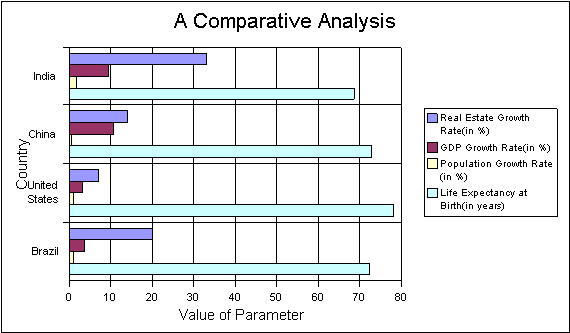Globalisation in the Real Estate Industry
Please note that we are not authorised to provide any investment advice. The content on this page is for information purposes only.
[br] Globalisation has transformed the world into a household, the members of which are heavily dependent on each other. Economists all over the world firmly believe that globalisation will bring in growth and development and the synergy will eliminate the present disparities. Asia is being accepted as the trusted brand of 21st century and real estate has a major role in it. India is destined to make its mark in the real estate market.
Indian world-class real estate: the factors propelling the boost
India’s rising demand for real estate is fueled by multidimensional components. IT is one of the major segments contributing to this surge. Estimates say that the IT sector will require a space of 150 million sq. ft. in major cities by 2010. The residential sector faces a shortage of 19.4 million housing units and the pattern of demand has changed with house seekers becoming more and more brand-savvy. Industry observers expect the Indian retail market to grow at a rate of 35 percent and thus generate an aggregate demand for 220 million sq ft by 2010. The reason for the above metamorphosis can be innumerable. According to analysts, this transformation is facilitated by significant rise in purchasing power, encouraging rates on home loans, favourable demographics etc. However, it is the direct and indirect benefits of globalisation that configure the precise campaign at work. The indirect benefits include an affluent middle class, a competitive market and a well-informed consumer. Below we depict the Indian growth and development scenario in comparison to other countries.

[br] As can be clearly seen, Indian real estate has a magnificent growth rate. China and United States fare better on the GDP and Life Expectancy fronts. But the real fascination for India is led by the potential returns from investment at the rate of 25-35 percent.
Recent changes in the global outlook of Indian real estate
The Indian government got rid of its ‘being isolated means being safe’ dogma in February 2005, when it permitted 100 percent foreign investments in construction and favoured fast-track approvals. According to a report prepared by property consultants Jones Lang La Salle, foreign investment of the order of US $ 10 billion will be flowing into India within next 12-18 months. Malaysia leads the show followed by UK, US, Israel and Singapore. The companies that are eager to make a fortune out of the bright prospects in India are: Signature of Dubai, Ayala of the Philippines, Och-Ziff Capital, EurIndia and Old Lane.
Employment scenario in the ocean of real estate
Globalisation of real estate in countries like India is a must from the viewpoint of unemployment and demographic profiles. India’s unemployment hovers around 6 percent and estimates show that at this rate anywhere between 19 and 37 million people (mostly consisting of educated youth) will be unemployed by 2012. Secondly demographic differentials has placed India at an advantageous position. The present population status concentrated in the younger age group indicate that many new opportunities can be optimally explored and real estate globalisation is one of them. This will be beneficial in providing self-employment through franchising and will open new vistas for the unskilled and semi-skilled workforce of India. But before entering the bull’s run, one must analyze the probability of actually hitting the bull’s eye. In reality, a courtyard common to all will be swept by none. There have been many instances when the Asian countries had a bitter experience due to artificial boom in the real estate brought in by the global funds. Sensex has seen unprecedented fluctuations in the last few years and so inflow with frequent checks is always welcome.




